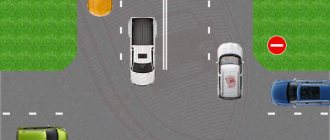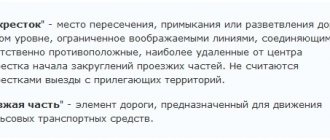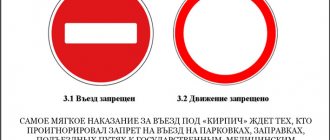What fines are preset for a no turn sign?
The extent and details of the penalty for violating the Traffic Rules are subject to the degree of danger of the action to the lives of others.
The following penalties have been developed for deviating from a turn prohibition:
- U-turn or turn within the range of the “Go straight ahead” sign - 1-1.5 tr. except for traveling to the adjacent territory.
- U-turn or turn to the left in the range of prohibitory signs - 1-1.5 tr.
- U-turn or turn to the right in the range of prohibition signs - 500 rubles.
- The owner of the car did not give way while turning - 1 t.r.
- The vehicle entered a unidirectional lane of oncoming traffic - from 5 tr. until the driver's license is withdrawn for six months.
Rotate through a solid line
A serious violation, for which you can pay with money and deprivation of the ability to drive a vehicle, is considered to be intentional or unintentional crossing of a solid line.
Article 12.15 of the Code of Administrative Offenses makes it very clear that if a road user drove into the oncoming lane and moved in the direction of oncoming cars, then he faces a fine of 5,000 rubles. Also, the motorist may lose his driving license for a period of 4 to 6 months. What the actual penalty will be depends on each specific situation: the degree of danger that entailed or could entail harm to passengers, pedestrians and surrounding vehicles is considered.
Referring to Article 12.16 of the Administrative Code, you can receive a fine if the requirements of signs and markings are violated. You can be fined for this in the amount of 1000 to 1500 rubles.
For example, it happens that a person driving, before reaching a broken line or intersection, begins to make a U-turn or turn through a continuous strip. Of course, such maneuvering is considered a violation: you will have to pay up to 1,500 rubles for your mistake.
Even if it is necessary to make a U-turn through a continuous lane, you can incur an administrative penalty - the amount can vary from 1000 to 1500 rubles. Such a need may be in the following situations:
- when a turn is required, for example, due to a possible impact with a suddenly fallen tree;
- if you had to turn or turn around to avoid a collision with a vehicle that suddenly stalled on the roadway.
When the driver leaves the yard and needs to turn left, a solid marking line is crossed. This is often accompanied by driving onto a main two-way road. If a maneuver in the wrong place is recorded on cameras or by traffic police officers, then a fine of 500 rubles will be imposed on the driver.
"Moving Straight"
The specified road sign allows the car owner to move exclusively in a straight direction, prohibiting the use of other maneuvering options.
If a sign is installed at a road intersection, its powers affect only this intersection. If it is placed outside an intersection, then its influence extends within the road until the nearest intersection. In this case, there is no prohibition on turning to the right if you need to get into nearby territory. Route buses, trolleybuses and trams may not be subject to this restriction.
An important note is that the sign in question may be located in a break in the demarcation strip to prevent vehicles from turning left and making a U-turn.
A serious violation is the intentional or unintentional crossing of a solid line.
This sign warns the driver against entering the oncoming lane and driving on a one-way road. Since this is unsafe both for the owner of the car and for other car owners and pedestrians, this violation is subject to deprivation of rights.
Road sign danger
A danger road sign prohibits the movement of all vehicles on a section of the road:
This sign is installed on sections of roads where temporary cessation of traffic is required due to any emergency situation. So if you come across this sign on the road, it will most likely be installed on a portable stand, i.e. We are talking about a temporary road sign.
In practice, I saw this sign only once, and no matter how crazy it may sound, it indicated a hole on the roadway. I think such a setup can confuse any driver.
If you come across a danger sign, I recommend driving around the section of road indicated by it. After all, it is possible that the sign was installed at the site of a real emergency.
"Right turns are prohibited"
This sign demonstrates that right turns are prohibited.
This rule does not affect the progress of public transport following the route. Its influence is distributed exclusively over the controlled intersection.
Ignoring the ban may result in the driver driving into an oncoming lane with one-way traffic. For such illegal behavior, the vehicle owner has the opportunity to lose his driver’s license for six months. You shouldn’t put your and other people’s lives at risk, even if you don’t mind having a driver’s license.
In the best case, that is, if the owner of the vehicle drives into an identical lane, he faces damage in the range of 500 rubles.
U-turn under the U-turn sign is prohibited
— — Consequently, this is a pure violation of the requirements of the sign, the punishment for which is provided for in Part 1 of Article 12.16 of the Administrative Code - a warning or a fine of 300 rubles.
In this case, we are again dealing with a left turn in violation of the requirements of the sign and markings. You can pay for this in accordance with Part 2 of Article 12.16 of the Administrative Code, that is, a fine of rubles.
Here, in order to make a left turn, the car had to take the extreme left position. That is, the maneuver had to start from the tram tracks in the same direction.
There is a violation of the Traffic Rules. Since the driver did not take the extreme position, the qualification will be under Part 1 [1] of Article 12.14 of the Administrative Code - a warning or a fine of 100 rubles.
Part 4 of Article 12.15 caused a huge amount of controversy due to the qualification of some reversals. The fact is that the turning trajectory is not specified in the rules.
Therefore, the difficulty arose: is it considered a violation of the rules to make a U-turn along the shortest path around a lawn or boulevard?
And if you count, then under what article should you qualify?
Is this a violation of the rules of turning around or is it still driving into the oncoming lane. The amendments to the code leave no doubt. There is no violation of the rules. In this case, there are two intersections on the road. Having left one of them, the driver found himself in the lane of oncoming traffic, which is prohibited by the rules. Therefore, his maneuver will be qualified under Part 4 of Article 12.15 of the Administrative Code. One-way traffic is regulated only by the presence of road signs, so the legislator has established a separate offense for this violation.
That is, I allocated Article 12.16 to Part 3. Until now, such a violation was assessed under Part 4 of Article 12.15 - driving on the side of the road in the opposite direction. The new article retains the old sanction - deprivation of the right to drive for 4 to 6 months - and provides for an alternative type of punishment in the form of a fine.
True, the maximum fine is 5,000 rubles.
"Left turn prohibited"
This sign prohibits right turns, but not U-turns. Like the one above, it does not affect buses, trams and trolleybuses. Spreads to the nearest intersection.
For violating this rule, the driver will face material damage in the amount of 1-1.5 tr. And this is the minimum punishment, since driving into the oncoming lane threatens five thousand or the confiscation of your license for six months.
In an excellent case, when turning left, you may encounter another sign restricting movement, which may prevent you from continuing your movement. An inattentive motorist will have to look for a way out of a difficult situation, from which he may not be able to get out without violating other rules.
Turning under the prohibitory sign “Go straight ahead”
All drivers know about the existence of road signs notifying the motorist about the prohibition/permission to turn or turn around.
Sign No. 4.1.1 means that the machine should only move straight. Failure to comply with the sign may result in a fine, although there are cases where the sign allows you to turn right. But even here, confusion arises, since motorists do not always understand whether maneuvering is possible in a particular case.
For example, by turning in an area where there is a “Go straight” sign, you can enter a narrow lane with heavy traffic and, with your incorrect manipulations, provoke an accident . Also, due to improper maneuvering, a traffic jam is likely to occur.
To avoid any disputes regarding the illegality of the installed sign, you need to keep in mind that:
- If the “Go straight ahead” sign is installed in front of an intersection, then it applies to a specific road intersection.
- If sign 4.1.1 is located outside the intersection of roads on a straight section, then it prohibits turning left and turning around until the nearest intersection, after which its effect ends.
If the driver of a vehicle entered an intersection or this intersection created a traffic jam, which forced other cars to stop, it means that the motorist, through his actions, created an obstacle for traffic moving in the transverse direction. For such a violation, the driver can be fined 1,000 rubles.
"U-turn prohibited"
This sign prohibits turning around at the intersection of roads, and concerns the entire intersection. Does not apply to public transport. As a rule, it is placed in places where the specified maneuver will become dangerous for surrounding cars and people.
In areas designated for public transport stops, turning around is also not permitted. In this area, car owners should be more careful, because there are often people there, and vision becomes limited.
Advice: if there is a characteristic sign at a stopping point, the area for prohibiting turning around is limited to 15 meters from all positions from the sign.
Sanctions for ignoring the ban are 1-1.5 tr.
When you can't turn left
One of the problems new drivers face is not knowing which signs prohibit turning left. So you stand at an intersection and don’t know whether such a maneuver will be a violation or whether it is allowed on this section of the road. According to statistics, it is turning to the left that is considered the most dangerous, difficult and provokes the formation of emergency situations. We have collected all the elements of road markings, according to which turning to the left is considered prohibited:
- First of all, it is worth noting the road marking element numbered 3.18.2, which is called “Left turn prohibited.” A white circle with a red border and a red line that crosses out a black arrow indicating movement to the left. All other directions are available to the driver, including changing the direction of travel by 180°.
- Next, we can recall the prescriptive symbols that indicate the permissible direction of movement. These include pointers 1.1, 4.1.2 and 4.1.4. According to them, movement can continue straight and to the right. If any of these signs are present, it is prohibited to turn to the left, as well as to change the direction of movement of the car in this direction. Although the sign, which indicates a straight-line direction, does not prohibit entering the courtyards of apartment buildings.
- Now you can remember about the road sign with the number 7.1, which indicates a road where traffic is in only one direction. You cannot turn left if there is a sign whose arrow points to the right.
- Don’t forget about the sign indicating that a separate lane is allocated for the movement of route vehicles. This designation is numbered 13.1, on which the arrow at the bottom should point to the right, and the top to the left. Only in this case is there a ban on turning on the left.
- There are symbols that indicate the permissible place and turning area (6.3.1 and 6.3.2, respectively). In addition to the image of an arrow, they may indicate the distance through which it will be possible to change the direction of movement of the machine. But turning to the left is prohibited in these places, even if it’s just entering a courtyard.
Road sign 3.18.2 “Left turn prohibited”
- Traffic Laws
- Traffic signs
- Fines
- traffic police
- Obtaining a driver's license
- Vehicle registration
Traffic signs Prohibition signs Road sign 3.18.2 “No left turn is prohibited”
In some cases, traffic at an intersection is organized in such a way that drivers must be prohibited from turning left, while traffic in all other directions, as well as U-turns, are allowed. A left turn is more difficult than a right turn. Because the driver has to give way to vehicles coming from other directions. This is not always convenient and sometimes leads to problems with movement. It is for this reason that left turns are often prohibited on this or that road section. For this purpose, road sign 3.18.2 “Left turn prohibited” is used.
Sign 3.18.2 is also often installed to regulate the flow of traffic at the entrance to a gas station. Installing a sign allows you to optimize traffic flow. Walking through a gas station, organizing its movement in only one direction, from entrance to exit.
This sign is classified as prohibiting and has a round shape typical for this category of signs and a white background with a red border, which depicts a crossed out black arrow turning left.
The sign is usually installed directly at the intersection where it is prohibited to turn right. At the next intersection, a left turn will be allowed (unless, of course, another sign 3.18.2 is installed there).
We advise drivers to pay attention to the fact that sign 3.18.2 “No left turn” is valid not at the intersection, but at the intersection (at one intersection there can be several intersections, and the sign is valid only for the first of them, for the rest the above maneuver quite acceptable).
The traffic rules allow the installation of sign 3.18.2 at a certain distance from the intersection. In this case, the exact distance from the sign to the intersection will be indicated on information plate 8.1.1. This preliminary installation of the sign allows the driver to orient himself in time and, if necessary, Correct the route in a timely manner.
By the way, sign 3.18.2 does not apply to route vehicles. This is done in order to provide city transport with unimpeded passage and improve the quality of passenger transportation.
What is the fine for turning and turning in the wrong place?
Adequate behavior of the driver and his correct maneuvers on the roadway will save the lives of passengers and pedestrians, keep him and surrounding vehicles safe and sound, and also protect him from unexpected expenses for paying fines.
The article will discuss what penalties are imposed for turning around and turning in the wrong place.
There may be different situations on the road, and in this regard the legislation contains an accessible and detailed description of those road incidents that occur most often. The Code of Administrative Offenses has provisions establishing a penalty for a U-turn that was made on. Controversial situations often occur on the road, and they happen due to the fact that not all drivers are promptly familiar with changes in traffic rules regarding markings, etc.
provisions. Traffic police officers advise following road signs as a guide.
Their purpose is to notify drivers that a particular action is prohibited.
Important! For maneuvering on a crossing marking with a minor entry, a fine of 2000 rubles is imposed. A spade, a zebra crossing, or a U-turn must be recorded on video, which will be grounds for a fine.
It happens that there is no roadway, but making a U-turn is clearly prohibited, as in the case of a U-turn at a zebra crossing. This provision is not subject to any comments or discussions: the requirements of the Code must be followed. For example, a pedestrian can freely cross the road even where it is not installed.
Naturally, on special traffic islands, vehicles should not make a U-turn, in accordance with paragraph 2 of Article 12.15 of the Code of Administrative Offenses. All drivers know about the existence of road signs notifying the motorist about the prohibition/permission to turn or turn around. Sign No. 4.1.1 means that the machine should only move straight.
Failure to comply with the sign may result in a fine, although there are cases where the sign allows you to turn right.
But even here, confusion arises, since motorists do not always understand whether maneuvering is possible in a particular case.










